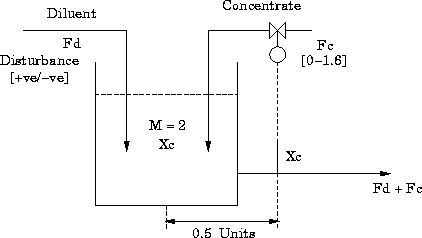The Mixing Process
Aims of Experiment
The aims of this experiment are:
- To appreciate the difficulties in trying to tune a controller for a
real process
- To compare the ZN open loop and closed loop methods for tuning a
controller
Theory
The theory required for this experiment is covered in
Module 2.2 - Controller Design and System Modelling
and
Module 4 - Additional Material.
However it is advisable to work through the other tuning experiments
before tackling this one,
Experimental Apparatus
Below is the experimental apparatus for this real
nonlinear process.

As can be seen there are two streams, a diluent and a concentrate,
mixing together in a tank. The aim is to keep the concentration of
concentrate constant by manipulating the flowrate of the concentrate stream.
The system is disturbed by altering the diluent flowrate.
Some notes on the system are listed below:
- The mass in the tank stays constant at 2 units, i.e. the flowrate
into the tank is the same as what comes out.
- The equations which model the system assume perfect mixing
- The measured/controlled variable is the concentration of the concentrate
in the tank.
- The measurement of this concentration is delayed by 0.5 time units.
- The adjusted variable is the flowrate of concentrate into the tank.
This value is limited to the range 0 - 1.6 mass units/time unit.
- The disturbance is the flow of diluent into the tank.
Procedure
This simulation can be split into three different parts. The experiment
can be run in one of three modes:
- No disturbance
- An increase in the diluent flowrate
- A decrease in the diluent flowrate
Since it is non-linear the response of the system to each of these
cases will be different.
The important thing to understand from this experiment is that the tuning
parameters therefore, will also be different.
For the first part it is a matter of looking at the response and saying
what it tells you about the process. For the second and third parts it
is necessary to look at the effect of the disturbance and try different
control parameters to return the process to its original state. To do
this simply enter the new values for the gain and reset time
and Rerun Simulation
Please move on to Pre-Experimental Questions

